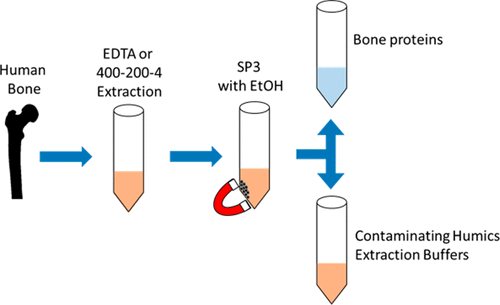当前位置:
X-MOL 学术
›
J. Proteome Res.
›
论文详情
Our official English website, www.x-mol.net, welcomes your feedback! (Note: you will need to create a separate account there.)
Human Bone Paleoproteomics Utilizing the Single-Pot, Solid-Phase-Enhanced Sample Preparation Method to Maximize Detected Proteins and Reduce Humics
Journal of Proteome Research ( IF 4.4 ) Pub Date : 2018-10-17 , DOI: 10.1021/acs.jproteome.8b00637 Timothy P. Cleland 1
Journal of Proteome Research ( IF 4.4 ) Pub Date : 2018-10-17 , DOI: 10.1021/acs.jproteome.8b00637 Timothy P. Cleland 1
Affiliation

|
Sample preparation has become an important part of bone proteomics and paleoproteomics and remains one of the major challenges to maximizing the number of proteins characterized from bone extractions. Most paleoproteomic studies have relied on in-solution digestion with the inclusion of filter-aided sample preparation (FASP) as effective methods to detect the proteome. However, neither of these are optimal because few proteins have been detected utilizing only in-solution digestion and the molecular weight cutoff of FASP may miss remaining fragments of proteins in fossil bone. The recently developed single-pot, solid-phase-enhanced sample preparation (SP3) overcomes these issues by not relying on molecular weight while still controlling where the proteins are digested. Here, historical human bones were extracted with either 500 mM tetrasodium EDTA or 400 mM ammonium phosphate dibasic, 200 mM ammonium bicarbonate, 4 M guanidine HCl and digested with the SP3 method. Across all samples, 78 ± 7 (400-200-4) and 79 ± 17 (EDTA) protein accessions were identified, including previously difficult to detect proteins such as osteopontin. SP3 also effectively removed 90% or more of the coextracting humic substances (based on reduced absorbance) from extracted proteins. The utility of SP3 for maximizing the number of protein detections in historical bones is promising for future paleoproteomic studies.
中文翻译:

人骨古蛋白质组学,利用单电位,固相增强的样品制备方法来最大化检测到的蛋白质并减少腐殖质
样品制备已成为骨蛋白质组学和古生物学的重要组成部分,并且仍然是最大程度地提高从骨提取物中鉴定出的蛋白质数量的主要挑战之一。大多数古生物学研究都依靠溶液内消化,其中包括过滤辅助样品制备(FASP)作为检测蛋白质组的有效方法。但是,这两种方法都不是最佳方法,因为仅通过溶液内消化就很少检测到蛋白质,并且FASP的分子量截断值可能会遗漏化石骨中残留的蛋白质片段。最近开发的单罐固相增强样品制备(SP3)通过不依赖分子量,同时仍控制蛋白质的消化位置,克服了这些问题。这里,用500 mM EDTA四钠或400 mM磷酸氢二铵,200 mM碳酸氢铵,4 M盐酸胍提取历史人类骨骼,并用SP3方法消化。在所有样品中,鉴定出78±7(400-200-4)和79±17(EDTA)蛋白质,包括以前难以检测的蛋白质,如骨桥蛋白。SP3还可以有效地从提取的蛋白质中去除90%或更多的共提取腐殖质(基于降低的吸光度)。SP3用于最大化历史骨骼中蛋白质检测数量的实用程序对于未来的古生物学研究很有希望。包括以前难以检测的蛋白质,例如骨桥蛋白。SP3还可以有效地从提取的蛋白质中去除90%或更多的共提取腐殖质(基于降低的吸光度)。SP3用于最大化历史骨骼中蛋白质检测数量的实用程序对于未来的古生物学研究很有希望。包括以前难以检测的蛋白质,例如骨桥蛋白。SP3还可以有效地从提取的蛋白质中去除90%或更多的共提取腐殖质(基于降低的吸光度)。SP3用于最大化历史骨骼中蛋白质检测数量的实用程序对于未来的古生物学研究很有希望。
更新日期:2018-10-18
中文翻译:

人骨古蛋白质组学,利用单电位,固相增强的样品制备方法来最大化检测到的蛋白质并减少腐殖质
样品制备已成为骨蛋白质组学和古生物学的重要组成部分,并且仍然是最大程度地提高从骨提取物中鉴定出的蛋白质数量的主要挑战之一。大多数古生物学研究都依靠溶液内消化,其中包括过滤辅助样品制备(FASP)作为检测蛋白质组的有效方法。但是,这两种方法都不是最佳方法,因为仅通过溶液内消化就很少检测到蛋白质,并且FASP的分子量截断值可能会遗漏化石骨中残留的蛋白质片段。最近开发的单罐固相增强样品制备(SP3)通过不依赖分子量,同时仍控制蛋白质的消化位置,克服了这些问题。这里,用500 mM EDTA四钠或400 mM磷酸氢二铵,200 mM碳酸氢铵,4 M盐酸胍提取历史人类骨骼,并用SP3方法消化。在所有样品中,鉴定出78±7(400-200-4)和79±17(EDTA)蛋白质,包括以前难以检测的蛋白质,如骨桥蛋白。SP3还可以有效地从提取的蛋白质中去除90%或更多的共提取腐殖质(基于降低的吸光度)。SP3用于最大化历史骨骼中蛋白质检测数量的实用程序对于未来的古生物学研究很有希望。包括以前难以检测的蛋白质,例如骨桥蛋白。SP3还可以有效地从提取的蛋白质中去除90%或更多的共提取腐殖质(基于降低的吸光度)。SP3用于最大化历史骨骼中蛋白质检测数量的实用程序对于未来的古生物学研究很有希望。包括以前难以检测的蛋白质,例如骨桥蛋白。SP3还可以有效地从提取的蛋白质中去除90%或更多的共提取腐殖质(基于降低的吸光度)。SP3用于最大化历史骨骼中蛋白质检测数量的实用程序对于未来的古生物学研究很有希望。



























 京公网安备 11010802027423号
京公网安备 11010802027423号